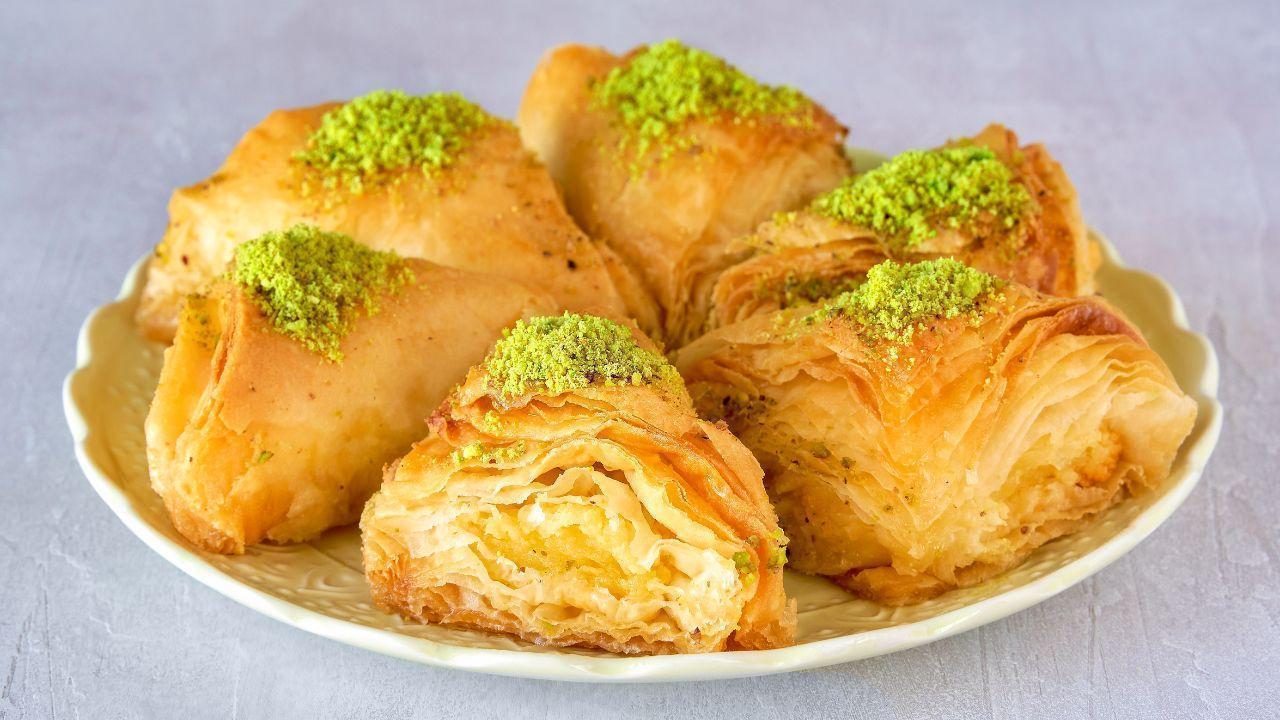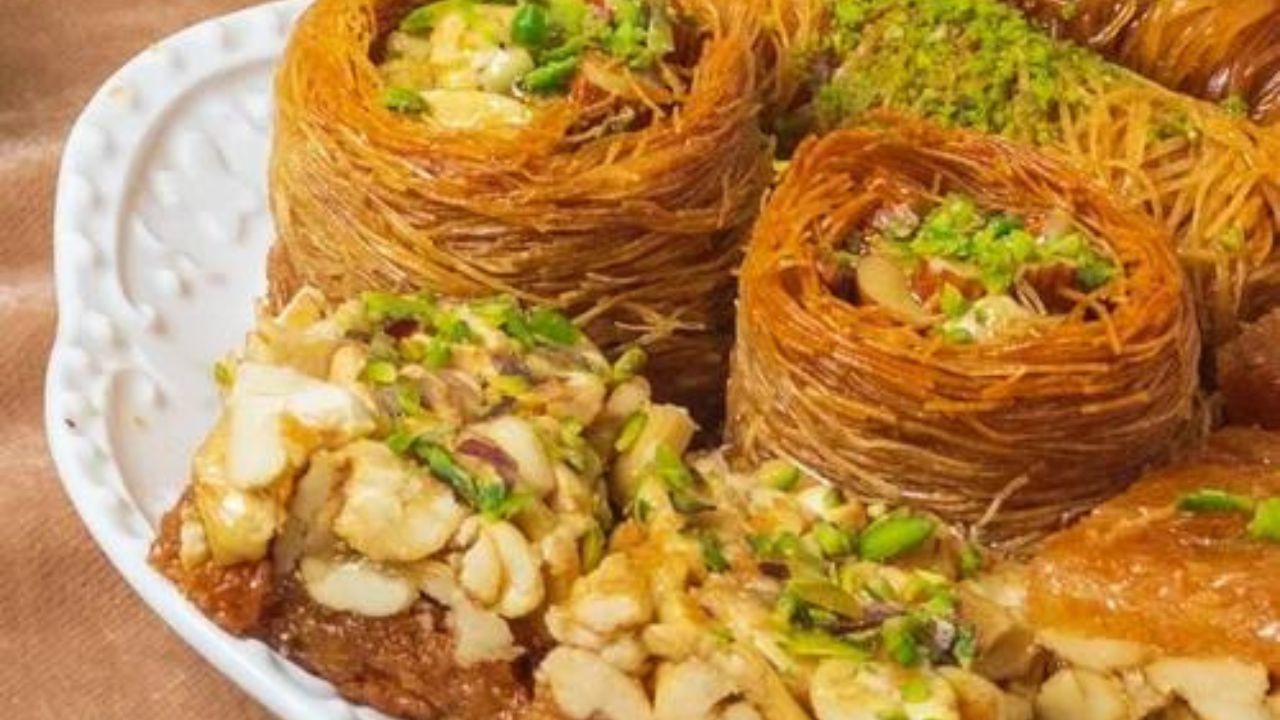
Post by: Kanchan Chandel
Middle Eastern cuisine is renowned for its rich flavors, aromatic spices, and vibrant culinary traditions. Among its most beloved offerings are the decadent desserts that tantalize the taste buds and tell stories of cultural heritage. Two such desserts that stand out are Baklava and Kunafa. These sweet treats, each unique in its own right, have captured the hearts of dessert lovers around the globe. Let's embark on a delightful journey to explore the intricate world of Baklava and Kunafa, uncovering their origins, ingredients, preparation methods, and the sensory experiences they offer.
Baklava is not just a dessert; it’s a piece of history that dates back thousands of years. The earliest mentions of something resembling baklava come from the Assyrians, who lived around the 8th century BCE. They created a rudimentary version by layering thin pieces of dough with nuts and drenching it in honey. This early form of baklava was enjoyed by the wealthy and was often reserved for special occasions due to the labor-intensive process and the luxurious ingredients.
As centuries passed, baklava evolved, influenced by various cultures and empires that ruled over the Middle East and Mediterranean regions. The modern version of baklava that many know and love today owes much of its refinement to the Ottoman Empire, which reigned from the late 13th century until the early 20th century. The Ottomans took the basic concept of baklava and perfected it, adding their unique touches and spreading it across their vast empire, which included parts of Europe, Asia, and Africa.
The Ottomans introduced the use of phyllo dough, a tissue-thin pastry that, when baked, turns into a light, flaky crust. They also incorporated a variety of nuts, such as walnuts, pistachios, and almonds, catering to regional tastes and available produce. Additionally, they enhanced the sweet syrup with floral essences like rosewater and orange blossom water, adding a fragrant note that elevated the dessert's flavor profile.
This rich history is what makes each piece of baklava so special. It's not just a sweet treat; it's a culmination of centuries of culinary evolution and cultural exchange. When you bite into a piece of baklava, you're experiencing a dessert that has been cherished and perfected over millennia, reflecting the tastes and traditions of countless generations.

Baklava is a culinary masterpiece, crafted with care and precision. The foundation of this dessert is phyllo dough, a paper-thin pastry that requires delicate handling. Here’s a closer look at how this delightful treat comes together.
Layering the Phyllo: Start by brushing a baking dish with melted butter. Lay down a sheet of phyllo dough and brush it with more butter. Repeat this process, layer after layer, until you have about ten sheets.
By understanding each step and ingredient, you can appreciate the artistry involved in making baklava. This dessert isn't just about satisfying a sweet tooth; it's about savoring a piece of culinary heritage that has been perfected over centuries.
The magic of Baklava unfolds the moment you take your first bite. As your teeth sink into the delicate layers of phyllo dough, you are met with an irresistible crunch that is both light and satisfying. This initial crispness quickly gives way to the rich, nutty filling nestled between the layers. The nuts—whether it's the earthy warmth of walnuts, the subtle sweetness of pistachios, or the robust flavor of almonds—add a hearty, crunchy texture that contrasts beautifully with the flaky dough.
But the journey doesn't end there. As you continue to savor the Baklava, the syrup, which has soaked through the layers, begins to make its presence known. This syrup, often kissed with the fragrant notes of honey, rose water, or orange blossom, infuses each bite with a luscious sweetness. It’s a sweetness that's perfectly balanced—not too overpowering, but enough to bring all the elements together in a harmonious symphony.
Each mouthful of Baklava is an experience of contrasts and balances. The crispiness of the phyllo provides a satisfying crackle, while the nuts offer a firm bite. The syrup adds a moist, tender finish, ensuring that each piece is both crunchy and succulent. This combination of textures and flavors creates a delightful interplay that keeps you coming back for more.
In essence, Baklava is more than just a dessert; it's a sensory delight that marries crisp, nutty, and sweet in perfect harmony. It’s this blend that makes Baklava a beloved treat across generations and cultures, inviting everyone to enjoy a timeless classic that is both simple and extraordinarily indulgent.
Kunafa, also spelled Kanafeh, is a dessert that has captured the hearts and taste buds of many across the Middle East and beyond. This beloved sweet has roots that intertwine with a variety of Middle Eastern cultures, including Palestinian, Lebanese, and Turkish cuisines. The exact origins of Kunafa are a topic of lively debate, but what remains undisputed is its widespread popularity and the joy it brings to those who indulge in it.
Kunafa is more than just a dessert; it is a symbol of celebration and community. Traditionally, it is prominently featured during the holy month of Ramadan. During this time, families and friends gather to break their fast, and Kunafa is often the star of the dessert table. Its presence during these gatherings highlights its role in bringing people together and marking special occasions with a touch of sweetness.
The history of Kunafa is as rich and layered as the dessert itself. Some stories suggest that it originated in the city of Nablus in Palestine, where it became known for its distinctive cheese filling and crispy, shredded phyllo dough topping. Over time, different regions put their own spin on the classic recipe, adding unique ingredients and preparation methods that reflect local tastes and traditions.
In Lebanon, Kunafa often includes a layer of thick, creamy custard in addition to the cheese, creating a luxurious texture and flavor combination. Turkish versions of Kunafa, known as Künefe, frequently use a special type of stretchy cheese called Hatay, which gives the dessert an extra gooey and satisfying bite.
Kunafa's journey across different cultures and countries has led to a variety of delightful interpretations, each adding to its rich tapestry of flavors and textures. Despite these regional variations, the core essence of Kunafa remains the same: a deliciously sweet and cheesy treat that brings joy and indulgence with every bite.
Today, Kunafa is enjoyed not only in the Middle East but also in many parts of the world, where people have fallen in love with its unique taste and the sense of tradition it embodies. Whether served at a festive gathering, as a special treat after a meal, or simply enjoyed with a cup of tea or coffee, Kunafa continues to be a dessert that delights and satisfies, bridging cultures and generations with its irresistible charm.
Kunafa stands out with its unique use of shredded phyllo dough or semolina dough. This dough forms both the crunchy base and the crispy topping of the dessert. The process begins by generously coating the shredded phyllo dough with melted butter, ensuring each strand is well-covered. This buttered dough is then carefully pressed into a baking pan, creating a sturdy base for the dessert.
The heart of Kunafa is its luscious cheese filling. Traditional recipes often use Nabulsi or Akkawi cheese. These cheeses are favored for their mild, slightly salty flavor and excellent melting qualities. The cheese is soaked in water beforehand to reduce its saltiness, ensuring a balanced taste in the final dish.
Once the base is ready, the cheese is spread evenly over it. Another layer of butter-coated shredded phyllo or semolina dough is then added on top, completely covering the cheese. This dual-layer construction ensures that every bite of Kunafa offers a perfect balance of crispy and creamy textures.
Baking Kunafa is an art in itself. The dessert is placed in a preheated oven and baked until the top layer turns a beautiful golden brown. This process not only cooks the dough to a perfect crispiness but also ensures the cheese in the center becomes gooey and molten.
The final touch to Kunafa is the fragrant sugar syrup. This syrup is made by boiling sugar and water together, often infused with a touch of rose or orange blossom water for an extra layer of aroma and flavor. As soon as the Kunafa is out of the oven, the hot syrup is poured over it, allowing it to seep into the layers, adding sweetness and moisture.
This combination of crispy, buttery dough, gooey cheese, and fragrant syrup creates a dessert that is rich, indulgent, and utterly delicious. The contrast in textures and the balance of flavors make Kunafa a beloved treat in many Middle Eastern households and beyond. Whether enjoyed during festive occasions or as a special treat, Kunafa is sure to leave a lasting impression with its unique taste and delightful texture.
Kunafa is a dessert that surprises and delights with every bite. Imagine sinking your teeth into a golden-brown crust that crackles delicately under your fork. The outer layer shatters into a thousand crispy shards, revealing a warm, gooey center of soft cheese that stretches gently as you pull it apart. This contrast of textures is like a dance on your palate – crunchy yet tender, crisp yet yielding.
As you take your first taste, the subtle sweetness of the syrup dances lightly on your tongue, followed by a hint of saltiness from the cheese. It's a delicate balance, neither too sweet nor too savory, but just right. The flavors meld together in a harmony that is both comforting and exotic, transporting you to the bustling streets of the Middle East where each bite tells a story of tradition and craftsmanship.
Kunafa is not just a dessert; it's an experience. It invites you to savor the moment, to appreciate the artistry that goes into each layer, and to indulge in a sensory journey that leaves you craving more. Whether enjoyed alone or shared with loved ones, Kunafa leaves an impression that lingers long after the last bite is gone – a memory of warmth, sweetness, and the joy of discovering something truly special.
Middle Eastern desserts such as Baklava and Kunafa offer a journey through time and taste, each embodying centuries of culinary evolution and cultural exchange. Baklava, with its delicate layers of phyllo dough, nuts, and sweet syrup, reflects the refinement of the Ottoman Empire. Kunafa, on the other hand, captivates with its crispy phyllo crust and gooey cheese filling, showcasing regional variations across the Middle East. Both desserts blend textures and flavors in a symphony that delights the senses, making them beloved treats enjoyed worldwide.
At DXB News Network, we celebrate cultural diversity and the richness of global cuisine through informative content. The article on Baklava and Kunafa aims to explore the history, ingredients, preparation methods, and sensory experiences of these Middle Eastern desserts. While we strive for accuracy and authenticity, culinary traditions may vary regionally, and individual preferences can influence interpretations of these dishes. We encourage readers to explore and enjoy these desserts firsthand, appreciating their unique flavors and the stories they tell.
Baklava is made from layers of phyllo dough filled with nuts and sweet syrup, while Kunafa features shredded phyllo dough or semolina with a cheese filling, topped with syrup.
Both desserts require patience and attention to detail due to their delicate layers and specific baking techniques. With practice and following a good recipe, they can be successfully made at home.
Baklava dates back to ancient Assyrian times, evolving through the Ottoman Empire. Kunafa's exact origins are debated but are rooted in various Middle Eastern cultures, including Palestinian and Turkish.
Baklava traditionally uses nuts like walnuts, pistachios, and almonds, depending on regional preferences. These nuts add texture and flavor to the dessert.
Both desserts are best stored at room temperature in an airtight container to maintain their crispiness and flavors. Serve Baklava and Kunafa at room temperature or slightly warmed, accompanied by tea or coffee for a delightful experience.
#trending #latest #MiddleEasternDesserts #Baklava #Kunafa #CulinaryHeritage #SweetTreats #FoodCulture #breakingnews #worldnews #headlines #topstories #globalUpdate #dxbnewsnetwork #dxbnews #dxbdnn #dxbnewsnetworkdnn #bestnewschanneldubai #bestnewschannelUAE #bestnewschannelabudhabi #bestnewschannelajman #bestnewschannelofdubai #popularnewschanneldubai

Natural Remedies to Boost Your Plant Care Routine...Read More.

Explore the rise of global sports competitions from local origins...Read More.














7 Free Ghibli-Style AI Image Editors to Try Now
Transform your images into Ghibli-style art with these 7 free AI tools. From dreamy landscapes to an

China Conducts Military Drills Near Taiwan
China's coast guard conducted patrols, inspections, and drills near Taiwan as Beijing announced mili

Man City’s Haaland suffers ankle injury, awaits tests
Erling Haaland picked up an ankle injury in Man City’s FA Cup win. He will see a specialist to asses

New E-Skin Enables Touchless Control and Robot-Like Sensation
Revolutionary e-skin mimics human touch, allowing touchless control, aiding robots, and helping peop

UAE to Launch Digital Dirham CBDC by Year-End for Secure, Efficient Payments
The UAE will introduce its Digital Dirham CBDC by year-end, enhancing security, transparency, and ef